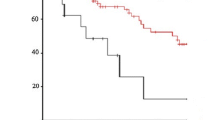Abstract
Esophageal resection is associated with a high incidence of operative mortality, suggesting the need for predictors of operative risk. A retrospective analysis was performed for esophagectomy patients using univariate and multivariate analyses; relative risks (RR) were calculated. Of the 269 patients, 35 (13%) died. The optimal model for the preoperative prediction of risk of mortality was defined by age ( p = 0.001; RR = 2.6) and performance status ( p = 0.04; RR = 1.9). Delimiting the data pool using a calculated risk of 0.2 accurately identified outcomes in 79% of patients and predicted 41% of deaths. The optimal model for the overall prediction of risk of mortality was defined by age ( p = 0.001; RR = 3.9), intraoperative blood loss ( p < 0.001; RR = 1.7), pulmonary complications ( p = 0.002; RR = 6.6), and the need for inotropic support ( p = 0.003; RR = 10.2). The individual risk of mortality after esophagectomy can be predicted preoperatively with a model based on patient age and performance status. The findings underscore the importance of preoperative evaluation of cardiopulmonary function, meticulous operative technique, and aggressive respiratory care in the management of the esophagectomy patient.
Similar content being viewed by others
Author information
Authors and Affiliations
Rights and permissions
About this article
Cite this article
Ferguson, M., Martin, T., Reeder, L. et al. Mortality after Esophagectomy: Risk Factor Analysis. World J. Surg. 21, 599–604 (1997). https://doi.org/10.1007/s002689900279
Issue Date:
DOI: https://doi.org/10.1007/s002689900279




